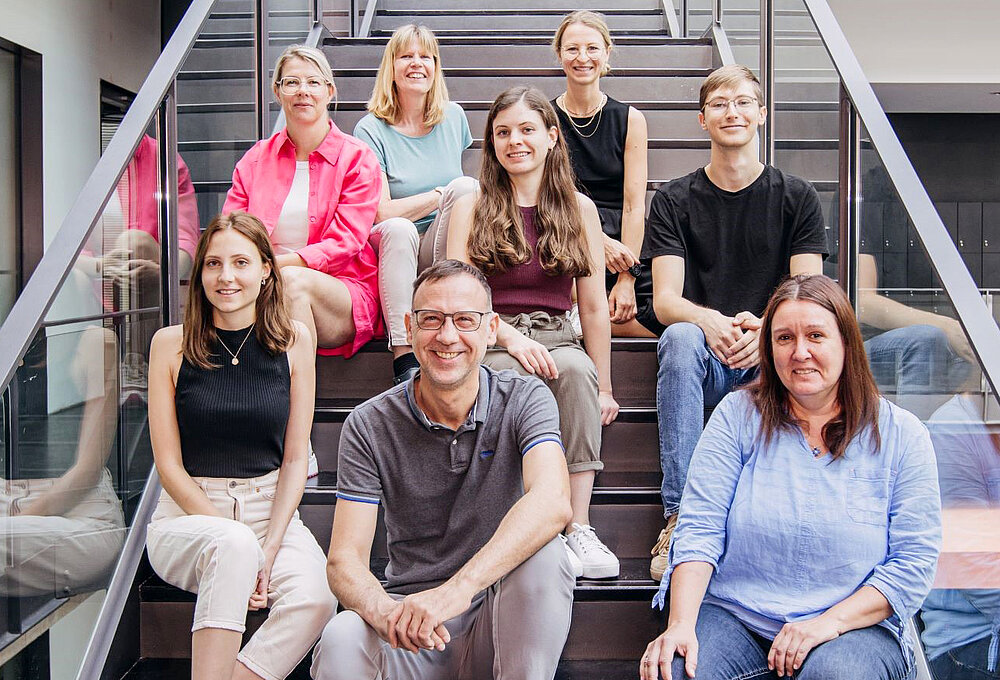Schlosser Group
The focus of our research is the development and application of mass spectrometric methods for the analysis of peptides and proteins.
Identification of protein interaction partners (interactome analysis)
We use quantitative mass spectrometric methods (label free, N15 labeling, SILAC) in combination with co-immunoprecipitation (CoIP) for identifying protein interaction partners. One of our major aims is the detection of transient and labile interactors. Cryogrinding applying a planetary ball mill allows gentle cell lysis and helps to avoid complex dissociation during the sample preparation (Uthe et al., 2017). We apply similar methods as for protein interactome analysis for the identification of cellular drug targets (Bach et al., 2017).
Identification of posttranslational modifications (PTMs)
We use mass spectrometric methods for identification, localization and quantification of PTMs, such as phosphorylation, ubiquitination (Dufner et al., 2015) or acetylation. For comprehensive PTM analysis, we combine digests with different proteases (e.g. elastase, thermolysin) and different mass spectrometric fragmentation techniques (HCD & ETD). We are especially interested in identifying unusual and unknown modification (Young et al., 2014; Jank et al., 2017).
We have recently developed a method that allows us to measure the site-specific acetylation degree (occupancy rate) on lysine residues (ElBashir et al., 2015). The new method allows for the first time an accurate determination of the site-specific acetylation degrees of all lysine sites within the N-terminal tail of histones (histone code). This method can be applied for example to measure comprehensively the effect of HAT and HDAC inhibitors on histone acetylation.
Analysis of HLA peptides
A more recent focus of our scientific work is the mass spectrometric analysis of HLA peptides. We isolate HLA peptides from tumor and analyze them with mass spectrometry. We have recently developed a new de novo sequencing-based data analysis strategy that allows the efficient identification of cryptic peptides. These peptides are derived from non-canonical open reading frames and originate e.g. from 5’-UTR, non-coding RNA or introns. Our aim is the identification of tumor-specific HLA peptides as targets for cancer immunotherapy.
We perform mass spectrometric analyses either in collaboration or as service project: RVZ Technology website
Turakhiya A, Meyer SR, Marincola G, Böhm S, Vanselow JT, Schlosser A, Hofmann K and Buchberger A (2018). ZFAND1 recruits p97 and the 26S proteasome to promote the clearance of arsenite-induced stress granules. Mol Cell 70:906-919.
Jank T, Belyi Y, Wirth C, Rospert S, Hu Z, Dengjel J, Tzivelekidis T, Andersen GR, Hunte C, Schlosser A, Aktories K. (2017) Protein glutaminylation is a yeast-specific posttranslational modification of elongation factor 1A. J Biol Chem 292:16014-16023.
Bach M, Lehmann A, Brünnert D, Vanselow JT, Hartung A, Bargou RC, Holzgrabe U, Schlosser A, Chatterjee M. (2017) Ugi Reaction-Derived α-Acyl Aminocarboxamides Bind to Phosphatidylinositol 3-Kinase-Related Kinases, Inhibit HSF1-Dependent Heat Shock Response, and Induce Apoptosis in Multiple Myeloma Cells. J Med Chem 60:4147-4160.
Uthe H, Vanselow JT, Schlosser A. Proteomic Analysis of the Mediator Complex Interactome in Saccharomyces cerevisiae. (2017) Sci Rep. 7:43584.
ElBashir R, Vanselow JT, Kraus A, Janzen CJ, Siegel NT, Schlosser A. (2015) Fragment Ion Patchwork Quantification for Measuring Site-Specific Acetylation Degrees. Anal Chem 87:9939–9945.
Dufner A, Kisser A, Niendorf S, Basters A, Reissig S, Schönle A, Aichem A, Kurz T, Schlosser A, Yablonski D, Groettrup M, Buch T, Waisman A, Schamel WW, Prinz M, Knobeloch KP. (2015) The ubiquitin-specific protease USP8 is critical for the development and homeostasis of T cells. Nat Immunol. 16:950–960. doi:10.1038/ni.3230.
Schmitt F, Vanselow, JT, Schlosser A, Kahnt J, Rössler W, Wegener C. (2015) Neuropeptidomics of the carpenter ant Camponotus floridanus. J. Proteome Res. 14:1504-1514.
Young JC, Clements A, Lang AE, Garnett JA, Munera D, Arbeloa A, Pearson J, Hartland EL, Matthews SJ, Mousnier A, Barry DJ, Way M, Schlosser A, Aktories K, Frankel G. (2014) The Escherichia coli effector EspJ blocks Src kinase activity via amidation and ADP ribosylation. Nat Commun 5:5887 | DOI: 10.1038/ncomms6887.
Melissa Bernhardt
Josef-Schneider-Str. 2
Stephanie Lamer
Josef-Schneider-Str. 2
Chiara Noemi-Marie Mireisz
Josef-Schneider-Straße 2
Dr. Andreas Schlosser
Josef-Schneider-Str.2
Beate Vogt
Josef-Schneider-Str. 2
Christiane Winkler
Josef-Schneider-Str. 2
Position
Professor for mass spectrometry and proteomics - Rudolf Virchow Center
The current term program can be found here.



